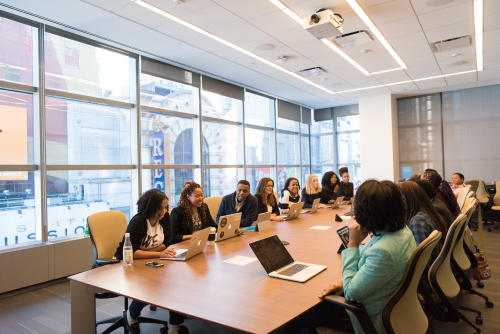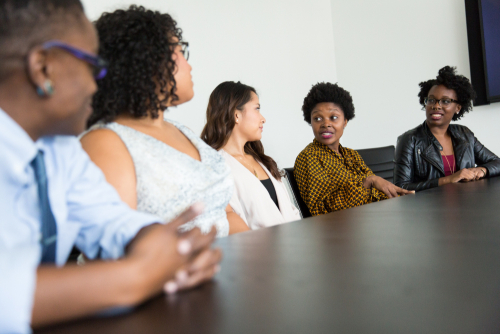Association leaders have a responsibility to make their association home for underrepresented populations
As America continues to better itself when it comes to diversity and inclusion, associations play a unique role in establishing standards to support underrepresented populations both in association leadership and in the industries they represent. While some associations opt for establishing diversity and inclusion committees, others may adopt policies aimed at increasing diversity among association members and leadership.
The ASAE Foundation’s paper, “Enhancing Diversity and Inclusion in Membership Associations,” found that there is no one-size-fits-all method or one correct way for impactful diversity and inclusion initiatives. A long-term view and plan must be put into place for associations to see any improvements.
Associations just getting started with developing their approach to diversity and inclusion have many options available to them. Read more about the role of equity in association DEI programs.
Defining Diversity and Inclusion
While some may think that diversity and inclusion refer only to initiatives related to skin color, there are far more considerations in addition to race: sexual orientation, gender, religion, age, family status, and more.

It might be easy to overlook or downplay one or more of the above factors as an area of potential discrimination. However, a study done by the Boston Consulting Group, which surveyed 16,500 employees from companies all around the world, found that around half of all workers from underrepresented groups report experiencing bias in their day-to-day work experience.
Associations represent a range of industries and, as a corollary, the diverse people in those industries. Establishing a dedicated diversity and inclusion initiative not only shows support for an association’s underrepresented members but helps advance their industries and improve the opportunity and experience for those underrepresented populations.
The Right Initiative
Now more than ever, people are looking to their employers, associations, and other organizations to be part of the social change so many feel is needed. Association leaders are vital to establishing and communicating the association’s role in eliminating racism, sexism, genderism, ageism, and more biases in society, the workplace, and beyond. That effort starts within the organization itself.
The ASAE paper reported that the more diligent an association is about its diversity and inclusion programs, the more the association is motivated to change. Specifically, if associations have clearly defined motivations for pursuing diversity and inclusion, the paper reported that those associations are more likely to be “proactive in their efforts to identify and address challenges to diversity and inclusion.”
Your association’s diversity and inclusion initiative may be created by staff leaders or the board of directors. Alternately, the association may commission a task force to draft what the association’s approach to diversity and inclusion will look like. The plan should include specific roles and responsibilities for various stakeholders throughout the association including staff, the board, volunteers, and members, and may be worked into the association’s code of conduct for members and volunteers. Board members may look outside the association at what their employers and other organizations are doing to promote diversity and inclusion and bring those ideas back to the association.
In conjunction with establishing your association’s diversity and inclusion initiative, associations are encouraged to create a diversity and inclusion committee that would set goals, promote diversity and inclusion throughout the association and industry, and hold stakeholders accountable on their roles in the association’s initiative.
When it’s time to roll out your diversity and inclusion initiative, plan for organization-wide communications that address the issues, the association’s stance on addressing those issues, and training to help reduce biases and increase cultural understanding within the association. This may be conducted with both association employees as well as volunteers and, if possible, membership-wide trainings. This clear communication not only broadly shares your association’s initiative to address diversity and inclusion but ensures that members and volunteers alike understand the association’s expectations for conduct. In addition, trainings and proactive communications about diversity and inclusion will help association leaders, staff, and members interact with others in a more inclusive way.

These are just some ways to create diversity and inclusion programs, there is no one-size-fits all solution. Associations may have to try and fail multiple times to finally succeed in designing something that can foster improvements for employees.
You Can Start Today
Associations are both workplaces and industry representatives of employees and employers from all backgrounds and encompassing a wide range of identities. Establishing programs, committees, and initiatives to support diversity and inclusion are an important step, but association leaders and staff outside of the underrepresented groups play an important role in ending discrimination in all its forms and standing up for their colleagues who identify as Black, Indigenous, and people of color (BIPOC), as well as those who may experience discrimination for their sexuality and gender identity, which includes those who identify as lesbian, gay, bisexual, transgender, queer, intersex, asexual (LGBTQIA), and beyond.
Dr. Oscar Holmes IV, the founder and CEO of WHConsulting and expert on organizational leadership and diversity issues, advises those who do not belong to underrepresented populations to make an effort to learn about the experience of their BIPOC and LGBTQIA colleagues.
“White colleagues can read reputable books on the topic; watch documentaries on the topic; take diversity and inclusion classes, webinars, and trainings; understand social issues and how laws affect these communities; and listen to BIPOC and LGBTQIA people when they share their experiences,” Dr. Holmes said. Hearing these experiences and understanding how your BIPOC and LGBTQIA colleagues feel about them can inform your own behaviors and interactions, helping you approach interactions with BIPOC and LGBTQIA colleagues in a more inclusive and mindful way.
Dr. Holmes also advocates for white and non-LGBTQIA people to stand up for their colleagues in difficult or awkward situations. For example, if someone says something sexist to a female colleague, makes a racist joke, or spreads a transphobic message in an email, speak up! Taking a stand against discriminatory or racist behavior in the workplace and being willing to speak up against it helps your colleagues feel safe and supported at work. Dr. Holmes also advises people to talk to BIPOC and LGBTQIA colleagues about what makes them feel unsafe and unwelcomed and what they can do to stop that from happening.
Creating and Fostering an Inclusive Environment
After understanding the issues present in the organization, association leaders then need to act on what they have been told by employees, outside information, and experts to create places—“brave spaces”—where difficult conversations can be held.
“Leaders need to adopt appropriate and inclusive organizational policies and practices, specifically broad anti-discrimination policies,” Dr. Holmes said. “Additionally, leaders should foster a psychologically safe environment so that employees can learn and come back from cultural faux pas, should they occur.”
When creating diversity and inclusion committees, associations must ensure that underrepresented groups are involved in the planning and implementation stages of the committee as well as developing the initiative.
AH client partner, the International Energy Credit Association (IECA), already had a Professional Women in Energy Group (PWEG), but in 2017 IECA expanded the mission of the group to focus on all types of diversity. The PWEG was transformed into the Professionals for Diversity and Inclusion Group (PDIG) and includes volunteers from all backgrounds who meet monthly to promote the importance of diversity and inclusionary practices and generate content for educational events that bring these issues to light.
IECA’s PDIG has set up a few webinars, membership Q&A calls, and networking events that bring members together across IECA’s diverse membership, in addition to providing speakers and session topics for IECA’s annual conference. The committee releases quarterly newsletters with industry-related articles about diversity to further the conversation outside of PDIG meetings.
“IECA’s PDIG has allowed IECA members to be involved in an open discussion on topics that change their professional and personal lives daily,” Jessica Hall, IECA’s assistant executive director said. “PDIG has given members a safe space to discuss challenges and obstacles they face within the workplace not related to their work, but other outside factors such as generation gaps, racial diversity, gender diversity, etc. By bringing these topics to the forefront for the IECA, we believe we have helped sculpt a more diverse and open IECA community.”
Dr. Holmes notes that an environment that is supportive of people’s identities can improve employees’ satisfaction, organizational commitment, job performance, and their well-being.
“Leaders should make strategic, identity-focused investments as necessary (e.g., employee resource groups, leadership pipeline programs, etc.), affirm everyone’s important social identities, respond to identity threat occurrences appropriately, increase their own and others’ cultural competencies/humility, create psychologically safe work environments, and ensure that a diverse group of people, particularly members of underrepresented groups, are recruited, hired, promoted, and supported in their organizations,” Dr. Holmes said.
Now is a critical time for organizations of all kinds, and especially member-based associations, to highlight the value of diversity and inclusion in their organizations and adopt practices that support and foster a positive, professional, and safe environment for underrepresented populations.
 Are you using the ASAE: The Center for Association Leadership Foresight Works Research to guide your conversations with your boards about what life looks like after COVID-19? What will change and what opportunities are being created?
Are you using the ASAE: The Center for Association Leadership Foresight Works Research to guide your conversations with your boards about what life looks like after COVID-19? What will change and what opportunities are being created?
AH has created a toolkit to help internal association executives with these conversations and for the first time, you can download a snapshot of this toolkit to use with your organization.




